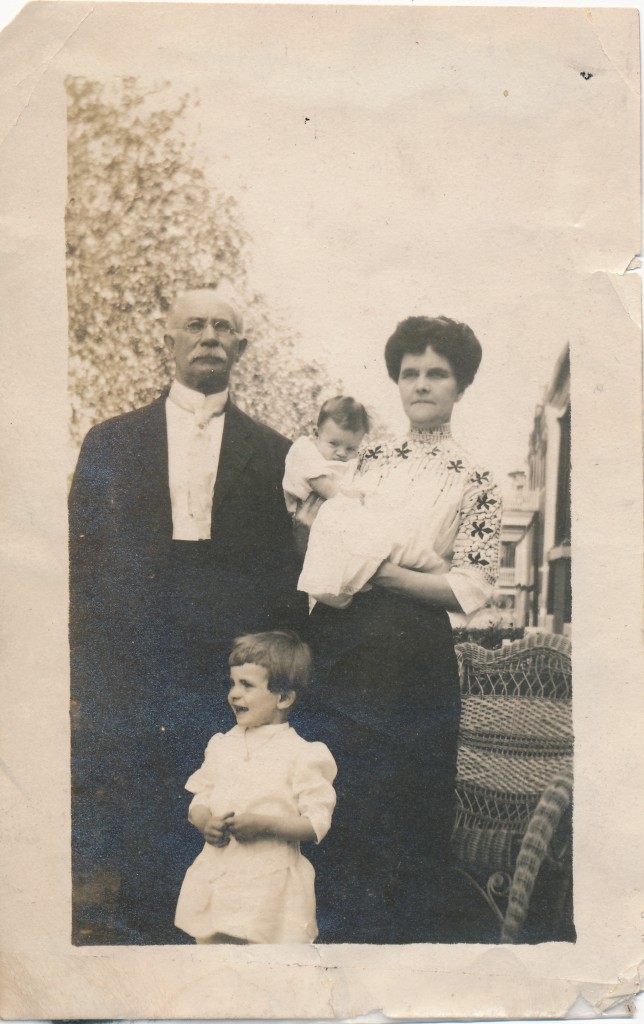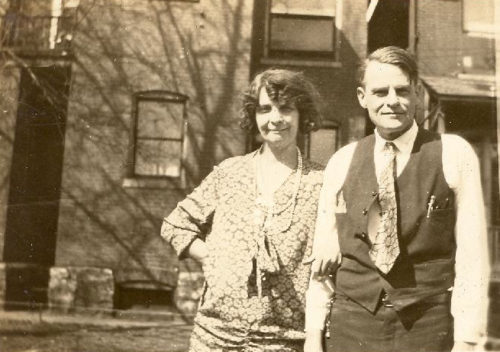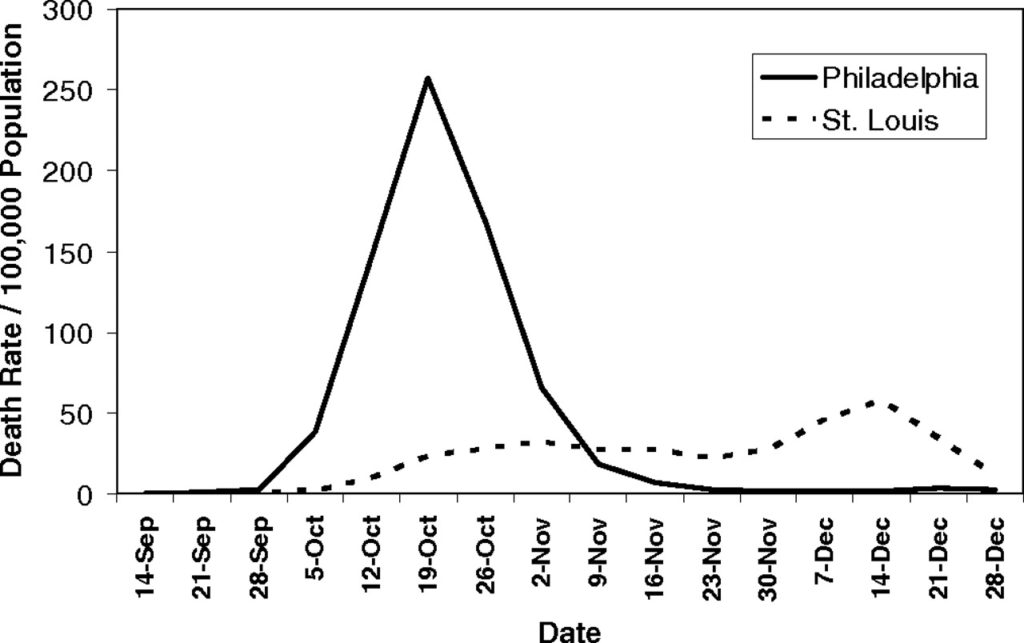Our Ancestors Lived through Pandemics Too: 1918 and the Springsteen-Beerbower-Helbling Family

Springsteen Family, Beerbower Family, Helbling Family (Click for Family Trees)
[If you are descended from Anna May (Beerbower) Helbling (1881-1954) and Gerard W. “G.W.” Helbling (1882-1971) of St. Louis, Missouri, these are your ancestors!]
As tough as our times are today with the Covid-19 (Corona virus) pandemic, we have ancestors who lived through pandemics too. Their smart thinking, the fact that they (probably) followed the directions of the experts at that time, and their good genes as well as perseverance helped them get through those difficult times. Love of their family was probably a big factor too!
Let’s go back to 1918, and the “Spanish Flu” outbreak. There are plenty of references to learn more about this pandemic, including a PBS documentary, “Influenza 1918.” Let’s explore a bit about our family in particular.
Our Springsteen family had a number of members who were likely living in Indianapolis, Indiana, in 1918. Jefferson Springsteen (1820-1909) and his wife, Anna (Conner) Springsteen (1824-1887) had lived there from about 1853. They had eight children, one of whom died as an infant and two sons who died prior to 1918. Their daughter Anna Missouri (Springsteen) Beerbower, mother of Anna May Helbling, may have been living in Indianapolis, as she had been born there and moved back a couple of times, her husband had passed away there in 1916, and we cannot find her listed in the 1920 Federal Census in any state. Anna’s sister Mary Elizabeth (Springsteen) Beckwith had been widowed- probably actually divorced- and was living with her daughter’s family in New York in 1915, but had moved back to Indianapolis by the 1920 census. Their younger brother, Abram Springsteen, “the youngest drummer boy of the Civil War” as the family lore called him, could also have been in Indianapolis, as he married there in 1912 but then was enumerated in the 1920 census in Washington, D.C. Their youngest brother, Robert E. Springsteen (1857-1931), is the only sibling that we know for sure was living in Indianapolis in 1918, but the others may have been there.
We are looking at Indianapolis, Indiana because there is an excellent article just published on the Indiana History blog about life there during the 1918 epidemic. “Coping with Quarantine in a Pre-Digital Era” is a great read that details how people spent their time during the 1918 quarantine. The information in the article would also probably apply to a large portion of the United States back then. The kids were out of school, it was a Congressional election year, and the economics and boredom of stay-at-home orders were challenging to all. The cause of the disease was unknown, there were no treatments nor vaccines for it, and the death toll in the US and around the world was staggering. (Any of this sound familiar?) The US was in the midst of World War I too, putting additional pressure on the people and government to keep going.

St. Louis, Missouri is another city to mention here, as Anna May (Beerbower) Helbling, daughter of Anna Missouri and Edgar P. Beerbower, lived there. With her husband Gerard William “G.W.” Helbling, she had three children living then: Edgar Bradley Helbling (1908-1994), Anna May Helbling (later Reilly) (1911-1985), and Viola Gertrude Helbling (later Carrigan) (1913-1971). Anna was expecting their fourth child, Robert Harvey Helbling (1918-2001), as the flu began, and “Bob” was born in August.
World War I was using Liberty Loan bonds to help finance the war, and a huge parade was held on September 28, 1918 in Philadelphia, Pennsylvania. It is estimated 200,000 people filled the streets to cheer on those in the parade and the war effort. Unfortunately the “Spanish Flu,” which had already attacked military bases and soldiers starting around March of 1918, was unknowingly present in the crowds as well. It only took 72 hours to fill all the beds in the city’s hospitals, and within a week, 2,600 civilians had died. One week later, the city’s death toll was 4,500. The city was short of doctors and nurses, as so many were in military service due to the War. With no antibiotics nor vaccines at that time, and health care workers using gauze facemasks that had holes large enough to allow most microorganisms through, containment was challenging. Philadelphia finally shut down schools and businesses, but they had waited too late- they could not keep the virus in check. (The 1918 flu was an H1N1 virus of avian origin, so not exactly like today’s corona virus, but still very virulent and hard to contain.)
Thankfully, Anna May and G.W. Helbling and their children were living in St. Louis at that time. It must have been frightening to have small children, including a newborn, as they read the newspapers and saw how the flu was raging across the country, and the world. (Their first child had died as an infant so they must have been very fearful.) The St. Louis city health commissioner was alarmed by the flu activity in the influenza hotspots of Boston and Philadelphia, and toward the end of September 1918, he knew that it would only be a matter of time before the “Spanish Flu” was seen in the Gateway City. He proactively set up a monitoring system, cancelled a Liberty Loan drive, educated the public through articles in the newspaper on how to prepare and avoid the flu, and once cases were being reported, he helped to get a public health emergency declared. Dr. Max C. Starkloff was then given more authority and closures of entertainment, schools, and churches were implemented by October 9th, with public gatherings banned. Those with medical knowledge worked with the city government to minimize any foothold in the community that the flu might gain. As cases of influenza increased, although at a much slower rate than in Philadelphia, St. Louis business hours were cut and then non-essential businesses and factories were closed to further protect citizens. (And yes, business owners and politicians were understandably worried about the economic impact to themselves, their city, and the country.) When restrictions were gradually lifted in mid-December because case numbers had diminished, new illnesses and deaths spiked in a second wave. Eventually, case numbers stayed low and removal of restrictions on December 28, 1918, added some joy to a difficult holiday season.

St. Louis is lauded as a city that looked into the future, followed medical advice, and quickly acted for the good of their citizens. What we now call “social distancing” helped to keep the city’s death toll to the sixth lowest in the country; Indianapolis was one of the five cities that had an even lower mortality rate, helping to save our family there. The graph above shows clearly the effect that physical distancing, done early and across the board, can have in an epidemic. This data has been studied by epidemiologists and will hopefully be heeded by governmental bodies and citizens to “flatten the curve” and reduce illness and deaths in our current pandemic. Implementing the 1918 tactics of St. Louis in 2020 can still buy us time for development of treatments and vaccines, and for ramping up manufacturing of materials needed for protection and treatment of patients and staff. The above graphs show that when strict measures are put in place early, the illnesses and deaths are much less than in places that have waited until the virus is rampant.
We are now experiencing in our day-to-day lives some of what our ancestors went through in those days of the 1918 Influenza Pandemic. Knowing that they survived through “social distancing” and the economic pain that ensued can help us have resilience and faith that we too can make it through this.
BTW, if you have a little extra time on your hands, the references below can be interesting reading. Reference #4 and #10 are particularly good, quick, and not terrifying. They also may give some comfort knowing that a whole lot of folks got to the other side despite not having the technology and scientific advances we have today. And while you are reading, think about how the ancestors only had newspapers, neighbors, local storekeepers and postal carriers to spread news. Sadly they also carried germs, but at least we have a better understanding of that today.
Notes, Sources, and References:
-
“Influenza 1918” on ‘American Experience’ on PBS. May be viewed online at https://www.pbs.org/video/american-experience-influenza-1918/
-
“Have Americans forgotten the history of this deadly flu?” https://www.pbs.org/newshour/nation/have-americans-forgotten-the-history-of-this-deadly-flu
- Anna Missouri (Springsteen) Beerbower lived with Anna May and GW Helbling in St. Louis possibly in the 1920s, and it is known she was there in the 1930s. We do have pictures of her there before the 1920s, but do not know if she was visiting or living there.
- “Coping with Quarantine in a Pre-Digital Era”
https://blog.history.in.gov/coping-with-quarantine-in-a-pre-digital-era/. Thank you, Dick Eastman, for featuring this article in your wonderful newsletter.: https://blog.eogn.com/2020/04/03/coping-with-quarantine-in-a-pre-digital-era/ - Anna May (Beerbower) Helbling and G. W. Helbling had two more children after the pandemic: William G. “Bill” Helbling (1920-2018) and Mary Theresa Helbling (later McMurray) (1925-2008).
- “Philadelphia Threw a WWI Parade That Gave Thousands of Onlookers the Flu” https://www.smithsonianmag.com/history/philadelphia-threw-wwi-parade-gave-thousands-onlookers-flu-180970372/
-
“The Spanish influenza of 1918 in St. Louis, Missouri.” https://www.ncbi.nlm.nih.gov/pubmed/16961567
-
“The American Influenza Epidemic of 1918-1919: St. Louis, Missouri” https://www.influenzaarchive.org/cities/city-stlouis.html#
- “Public health interventions and epidemic intensity during the 1918 influenza pandemic.” Richard J. Hatchett, et al, Proceedings of the National Academy of Sciences of the United States of America, May 1,2007. https://doi.org/10.1073/pnas.0610941104
- “This chart of the 1918 Spanish flu shows why social distancing works” by Michael J. Coren, March 11, 2020, Quartz. https://qz.com/1816060/a-chart-of-the-1918-spanish-flu-shows-why-social-distancing-works/
- “1918 Pandemic” https://www.cdc.gov/flu/pandemic-resources/1918-pandemic-h1n1.html
Click to enlarge any image. Please contact us if you would like an image in higher resolution.
We would love to read your thoughts and comments about this post (see form below), and thank you for your time! All comments are moderated, however, due to the high intelligence and persistence of spammers/hackers who really should be putting their smarts to use for the public good instead of spamming our little blog.